

As March nears its end, the season is about two weeks behind 2014 emphasising the erratic nature of our climate; 2013 was the very late season and 2012 a bit earlier than this year. Of course it can ALL change, and it probably will!
![]() As March nears its end, the season is about two weeks behind 2014 emphasising the erratic nature of our climate; 2013 was the very late season and 2012 a bit earlier than this year. Of course it can ALL change, and it probably will!
As March nears its end, the season is about two weeks behind 2014 emphasising the erratic nature of our climate; 2013 was the very late season and 2012 a bit earlier than this year. Of course it can ALL change, and it probably will!
Yesterday - 26th March The English Apple Man joined growers, technologists, agronomists et al at East Malling Research for The HDC (Horticultural Development Company) Tree Fruit Day.
A full day's programme covering research into a number of important issues concerning issues associated with top and stone fruit.
This week's English Apple Man Journal will look at two presentations; one dealing with storage of Gala apples and the other highlighting the importance of 'dry matter' - both concentrate on identifying the element critical to consumer satisfaction; "flavour".
Consumers may question why we should extend our season into the 'Southern Hemisphere' season where 'home grown' apples and pears stored for six months since harvest, are competing with 'new season' fruit just weeks after leaving the tree.
Wrapped up in the myriad of data gleaned from the research presentation by Dr. Richard Colgan, is one very telling statement; when long term stored UK apples are sourced from orchards meeting 'best practice' growing criteria and stored in the optimum storage conditions, the home grown fruit equaled and in some cases exceeded the organoleptic properties of new season imported Gala, even though they were picked 6 months apart!
 Dr. Richard Colgan - Extending the marketing season for Gala apples
Dr. Richard Colgan - Extending the marketing season for Gala apples
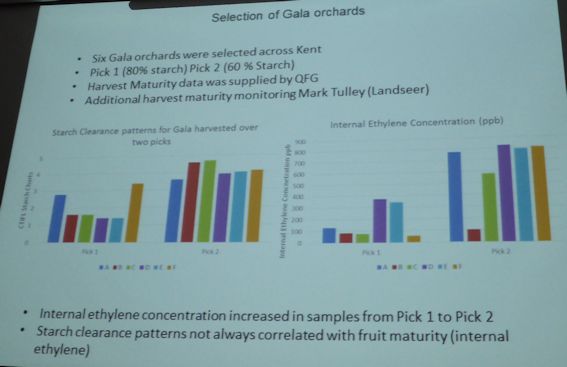 Richard is employed by the NRI (National Resources Institute) at Greenwich University; his role in storage research is focused through The Produce Quality Centre (PQC) a joint initiative between NRI and East Malling Research. The Jim Mount Building at EMR the UK's leading controlled atmosphere (C/A) research storage facility, with small C/A units holding sufficient fruit to trial a variety of different storage regimes for UK apples and pears, is integral to this research; this facility has been key to the success of commercial storage of UK top Fruit.
Richard is employed by the NRI (National Resources Institute) at Greenwich University; his role in storage research is focused through The Produce Quality Centre (PQC) a joint initiative between NRI and East Malling Research. The Jim Mount Building at EMR the UK's leading controlled atmosphere (C/A) research storage facility, with small C/A units holding sufficient fruit to trial a variety of different storage regimes for UK apples and pears, is integral to this research; this facility has been key to the success of commercial storage of UK top Fruit.
Richard emphasised the importance of extending the marketing period for UK Gala; with forecasts of a 40% increase in production of 'home grown' Gala in the next 3 - 4 years, extending the season for home grown Gala past April into May and possibly June is important if UK Gala growers are to 'survive and prosper'
Richard pointed out that traditionally UK Gala has been stored in 'one of two' regimes; 1% O2 and less than 1% CO2 and 0.5 degrees C until end of February, or 5% CO2 and 1% O2 and 1.5 - 2 degrees C until end of March/early April.
The harvest dates for Gala for long term storage follow the recommendations made by the Quality Fruit Group (QFG) who monitor fruit samples in the weeks leading up to the 'anticipated' harvest date and by recording starch levels, fruit pressures, brix (sugars) and background colour, forecast when the fruit should be picked depending on the planned storage period. The QFG modus operandi is of course based on the years of detailed storage trials carried out at East Malling coupled with the experience of scientific members of the QFG.
One of the critical elements is the stage of starch reduction, for instance fruit for long term storage must be picked before the starch level drops below the prescribed level. In the case of Gala for March marketing, fruit should be harvested at 80% starch pattern. The level of starch is an indicator for the level of maturity.
In the trial, Richard made assessments on two picking dates/stages; one at 80% starch and the second at 60% starch using six orchards across Kent. Internal Ethylene Concentration (IEC) in ppb (parts per billion) was also measured and comparison with starch measurement made.
Interestingly internal ethylene concentration increased in pick date samples 1 - 2 (as one would expect) but correlation between starch clearance patterns and maturity (internal ethylene) did not always align. Measurements for Dry Matter Content (DMC) Brix and fruit firmness were taken and evaluated.
Protocol for sensory evaluation
Gala samples removed from C/A store in April and June sent out for taste testing.
Tasters were presented with whole, randomly numbered apples and asked to assess each using a 1 - 10 score using the following criteria.
* Aroma (1 = bad - 10 = excellent)
* Flavour (1 = bad - 10 = excellent)
* Sweetness (1 = low - 10 = high)
* Acidity (1 = low - 10 = high)
* Firmness (1 = low - 10 = high)
* Crispness (1 = low - 10 = high)
* Off flavours (1 = bad - 10 = none)
* Overall acceptability ( 1 = 10 = excellent )
Standard measurements of Firmness (using a penetrometer) Brix (using refractometer)
Volatile measurements made on samples of 'whole and cut' fruit.
In addition to a number of different O2 / CO2 / Temperature - storage regimes, the use of SmartFreshSM as an integral element in some of the trial regimes added to the combinations researched by PQC.
The SmartFreshSM Quality System is globally recognized as an important tool for fruit quality management. SmartFresh successfully manages fruit and vegetable ripening by controlling naturally occurring ethylene during storage and transport.
Ethylene triggers ripening and spoilage in most fruits and vegetables, and can be responsible for storage disorders which can spoil products and result in loss and waste. SmartFresh reduces fruit waste and maintains the texture, firmness, taste and appearance of fruits by warding off negative ethylene effects.
Click on Smartfresh to visit Agrofresh website for more details.
 Tim Biddlecombe - Desk Study investigating relationship between Dry Matter Content and Fruit Quality
Tim Biddlecombe - Desk Study investigating relationship between Dry Matter Content and Fruit Quality
Tim who is MD of FAST the leading independent advisory company, and a key member of the Quality Fruit Group explained his research into Dry Matter Content was a 'desk study' sifting though documented research studies made by respected scientists at home and abroad.
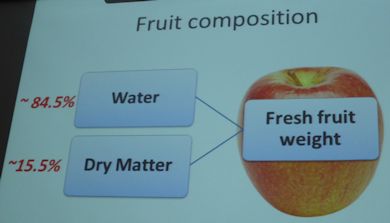 An apple is around 95% water but the composition of the remaining 5% dry matter is key to the eating quality of the fruit.
An apple is around 95% water but the composition of the remaining 5% dry matter is key to the eating quality of the fruit.
The influence of dry matter as a predictive tool is just one aspect; the factors governing DMC are numerous, but as one might expect, available light is critical, so tree shape is important. Tim raised the subject of reflective mulch on DMC; even in countries with high 'natural' light levels (New Zealand) reflective mulch will still raise the level of DMC.
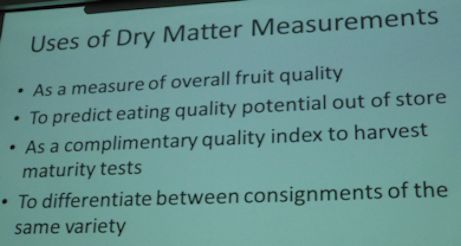
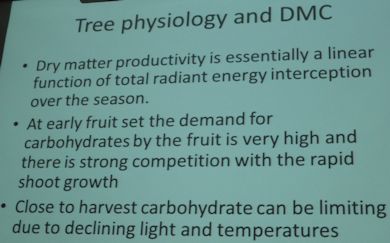
Dry matter may only represent 5% of the apple, but the influence of physiological factors on the composition of 'dry matter' and the importance of how 'dry matter' influences the storage and eating quality of the apple is incalculable at this stage (but getting closer).
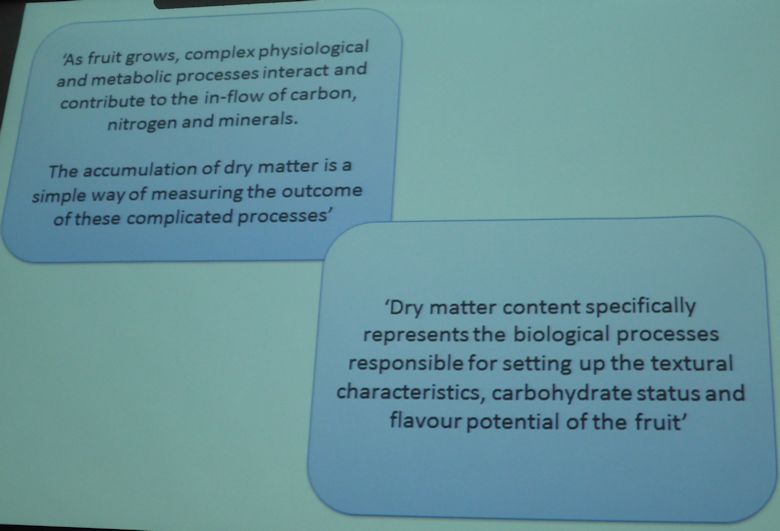
The HDC Tree Fruit Day at EMR covered so much detail; impossible to report on fully, however for English Apple Man readers seeking more information, the presentations will ALL be on the HDC (Horticultural Development Company) website early next week.
Click on HDC to access website.
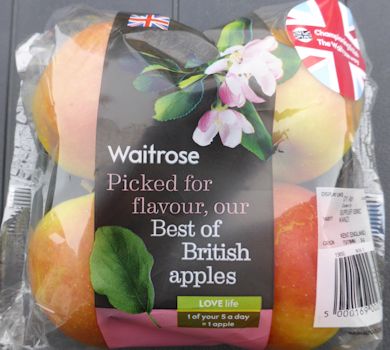
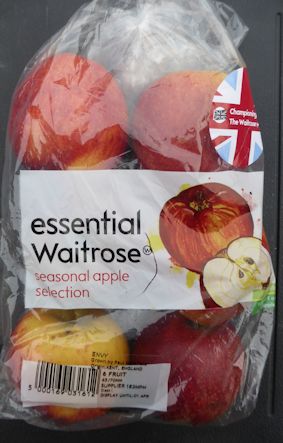 The English Apple season nears the end, but there are still excellent samples of home grown apples (and some Pears) on Supermarket shelves. Two purchased by The English Apple Man this week; Kanzi and Envy.
The English Apple season nears the end, but there are still excellent samples of home grown apples (and some Pears) on Supermarket shelves. Two purchased by The English Apple Man this week; Kanzi and Envy.
Both eat very well; the Kanzi has very good texture, crisp and very juicy with good flavour. The Envy very firm crisp and juicy with excellent flavour.
Go 'grab' an English apple before our season ends.................
That is all for this week..............
Take care
The English Apple Man